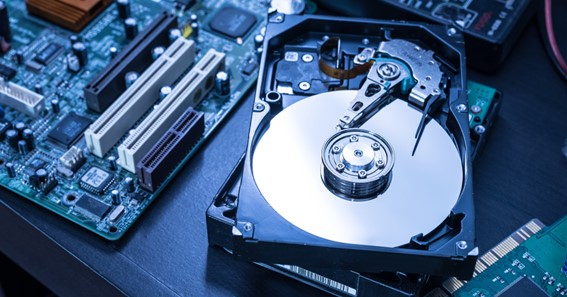Are you curious to know what is auxiliary memory? You have come to the right place as I am going to tell you everything about auxiliary memory in a very simple explanation. Without further discussion let’s begin to know what is auxiliary memory?
In the digital age, the need for efficient and reliable data storage has become increasingly important. While primary memory (such as RAM) provides fast and temporary storage for immediate data access, auxiliary memory, also known as secondary storage, offers a larger capacity for long-term data retention. In this blog, we will explore the concept of auxiliary memory, its functions, and its significance in expanding the boundaries of data storage.
What Is Auxiliary Memory?
Auxiliary memory refers to secondary storage devices or mediums that are used to store data for long-term or permanent retention. Unlike primary memory, which is volatile and loses its content when the power is turned off, auxiliary memory retains data even when the system is powered down. It serves as an extension of primary memory, providing a larger capacity to store files, documents, applications, and other data.
Functions And Types Of Auxiliary Memory:
Auxiliary memory serves several important functions in data storage:
- Data Persistence: Auxiliary memory ensures the persistence of data over extended periods, allowing for long-term storage and retrieval. It is commonly used for archiving, backup, and data retention purposes.
- Large Storage Capacity: Auxiliary memory provides significantly larger storage capacities compared to primary memory. This allows for the storage of vast amounts of data, including multimedia files, databases, and software applications.
- Non-Volatile Storage: Unlike primary memory, auxiliary memory retains data even when the power is turned off. This non-volatile nature ensures that data remains intact and accessible over extended periods.
There Are Various Types Of Auxiliary Memory, Including:
- Hard Disk Drives (HDDs): HDDs are mechanical storage devices that use spinning magnetic disks to store and retrieve data. They are widely used in computers and servers due to their large storage capacity and relatively low cost.
- Solid-State Drives (SSDs): SSDs utilize flash memory technology to store data. They provide faster access speeds, improved durability, and energy efficiency compared to HDDs, making them increasingly popular in modern computing systems.
- Optical Discs: Optical discs, such as CDs, DVDs, and Blu-ray discs, are optical storage mediums that use lasers to read and write data. They offer a portable and removable storage solution for music, videos, software, and other forms of media.
- Magnetic Tapes: Magnetic tapes are sequential access storage devices that use magnetic tape reels to store and retrieve data. They are commonly used for backup and archival purposes, offering high-capacity storage at a low cost.
Significance Of Auxiliary Memory:
Auxiliary memory plays a vital role in the world of data storage and management:
- Data Backup and Recovery: Auxiliary memory provides a means to create backups of critical data, protecting against data loss due to system failures, disasters, or human errors. It allows for the restoration of data to its previous state, ensuring business continuity and data integrity.
- Extended Storage Capacities: Auxiliary memory enables the storage of large volumes of data that exceed the capacity of primary memory. It provides the means to archive historical data, store multimedia content, and accommodate the growing storage demands of businesses and individuals.
- Portable and Removable Storage: Auxiliary memory devices, such as SSDs and optical discs, offer portability and ease of data transfer. They allow users to carry and access data across different devices and locations, providing flexibility and convenience.
- Long-Term Data Retention: Auxiliary memory facilitates long-term data retention and archiving. It preserves important records, research data, and historical information for future reference, analysis, and compliance with legal or regulatory requirements.
Conclusion:
Auxiliary memory serves as a critical component in the world of data storage, expanding the boundaries of capacity, persistence, and accessibility. With its larger storage capacities, non-volatile nature, and diverse range of storage mediums, auxiliary memory provides the means to store, protect, and retain vast amounts of data over extended periods. Whether for backup purposes, archiving historical records, or accommodating the ever-increasing storage demands of modern computing, auxiliary memory plays a significant role in preserving and managing the digital information that drives our interconnected world.
FAQ
What Is The Auxiliary Memory?
An Auxiliary memory is known as the lowest-cost, highest-capacity and slowest-access storage in a computer system. It is where programs and data are kept for long-term storage or when not in immediate use. The most common examples of auxiliary memories are magnetic tapes and magnetic disks.
What Are Examples Of Auxiliary Memory?
The best example of auxiliary storage is hard disk drives and optical storage media like CDs, DVDs, and Blu-ray. Other auxiliary storage belongs to the peripheral devices category as well, such as flash drives and any type of memory card.
Is Ram An Auxiliary Memory?
No, RAM is not auxiliary memory. It is a primary memory. The processor/CPU has immediate access to primary memory. And primary memory is temporary in nature.
What Type Of Memory Is Auxiliary Memory?
The correct answer is Secondary Storage. Auxiliary memory is popularly known as Secondary Storage.
I Have Covered All The Following Queries And Topics In The Above Article
What Is Auxiliary Memory In Computer
What Is Auxiliary Memory In Computer Architecture
What Is Auxiliary Memory With Example
What Is The Auxiliary Memory
What Is An Auxiliary Memory
What Is Auxiliary Memory Required
What Is Auxiliary Memory In Computer Organization
What Is Auxiliary Memory In Hindi
What Is Auxiliary Memory?
What Is The Need Of Auxiliary Memory
What Is The Difference Between Main Memory And Auxiliary Memory
What Is Auxiliary Memory
What is an example of an auxiliary memory
What is auxiliary memory in a computer?



